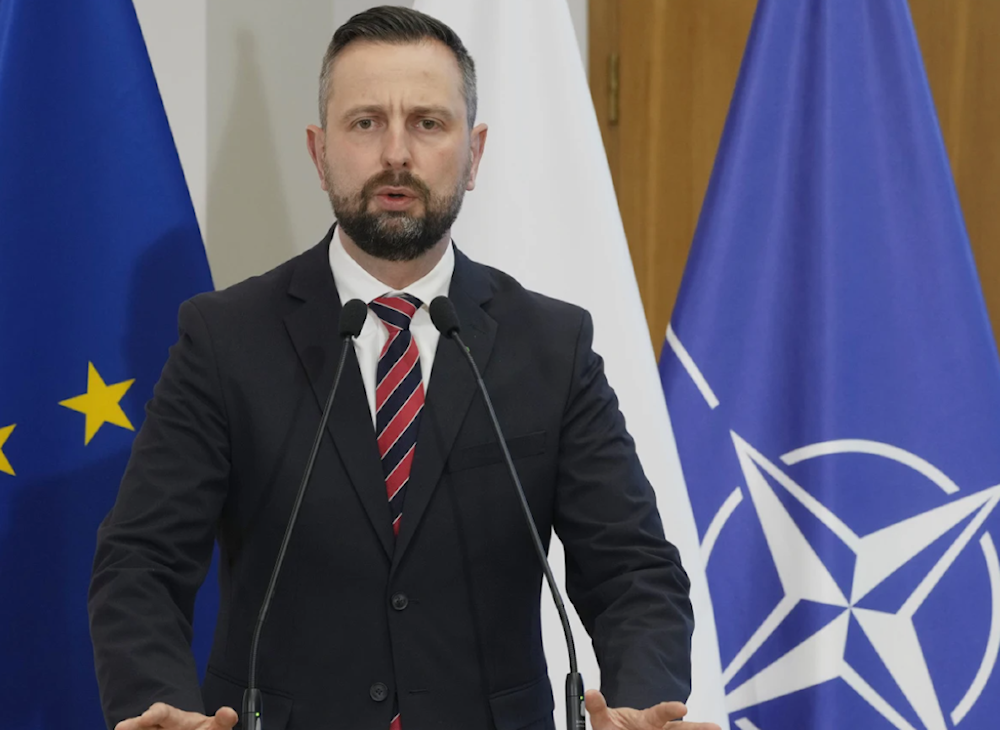NATO air defense capacity needed to protect eastern flank stands at 5%
According to the alliance's own evaluations, the lack of necessary systems in the event of a battle exposes weaknesses.
-

Poland's Defense Minister Wladyslaw Kosiniak-Kamysz speaks about a program of strengthening the defense of NATO's eastern flank in Warsaw, Poland on May 27, 2024. (AP)
Europe has only a quarter of the air defense capabilities required to cover its eastern flank, exposing the continent's vulnerabilities, NATO's official estimations revealed.
The war in Ukraine has highlighted the need for air defense, as Kiev begs the West for more systems and missiles to protect itself from Russian operations.
However, according to sources familiar with classified defense plans set up last year, NATO states can supply less than 5% of the air defense capacity required to protect its members in central and eastern Europe from a full-scale attack.
One senior NATO official stated that the capacity to defend against missiles and air attacks was "a major part of the plan to defend eastern Europe from invasion," adding, "And right now, we don't have it."
NATO foreign ministers will meet in Prague on Thursday for two days of discussions to prepare for the alliance's leaders' summit in Washington in July, where discussions will center on strengthening European defense.
Read more: Putin warns NATO: Consider the cost before strikes on Russia
The UK government classified the "challenge of protecting against attack from the skies" as "its most acute for over 30 years" during a comprehensive defense review last year.
Another NATO diplomat cited that it was undeniable that a lack of air defense was "one of the biggest holes we have."
The inability of European NATO members to provide Ukraine with new air defense weaponry in recent months has highlighted the continent's limited supply of costly and time-consuming systems.
Ukraine complains about M1 Abrams tanks after pleading for tanks
Ukrainian military crews maintaining the M1 Abrams tanks, provided by the United States, have raised concerns about the performance and suitability of the armored vehicles in the ongoing war, according to a report by CNN on Wednesday.
The Ukrainian crews highlighted several significant issues with the $10 million tanks, particularly their vulnerability to modern weaponry. They reported that the tanks' armor is insufficient against contemporary threats such as drones, failing to provide adequate protection for personnel. This shortcoming has made the Abrams tanks a prime target for Russian forces, one crew member noted.
🇺🇦🇷🇺‼️🚨 “This Abrams came fresh from Poland and it’s already broken down.”
— Lord Bebo (@MyLordBebo) May 29, 2024
LOL
pic.twitter.com/uTQeoIqIiF
Technical problems have also plagued the tanks, with condensation reportedly affecting electronic components.
Moreover, the Ukrainian crews argued that the M1 Abrams tanks were not well-suited to Ukraine's specific battlefield circumstances. Typically, air power and artillery are used to clear the battlefield before tanks and troops advance. However, Ukrainian forces lack these critical elements, making the deployment of the Abrams tanks less effective.
The United States has supplied 31 Abrams tanks to Ukraine, which are currently deployed near the frontlines in the eastern region of the country. The decision to send these tanks was controversial due to the complex supply chains and maintenance requirements associated with the vehicles.
It is also significant to note that these complaints come at a time when Ukraine is asking to be able to strike deep into Russian territory, and the complaint that Kiev's forces are unable to use the tanks properly because they don't have the proper weaponry to attack Russian positions that jeopardize said tanks directly means that this protest is just another bid to demand the usage of long-range weapons to target Russia.
This comes amid growing calls to permit Ukraine to use Western-supplied longer-range weapons to strike inside Russia. This issue has stirred debate among Kiev's allies, highlighting differences in their approaches to the conflict, with France being the latest to demand that Ukraine be allowed to attack Russia.

 4 Min Read
4 Min Read











